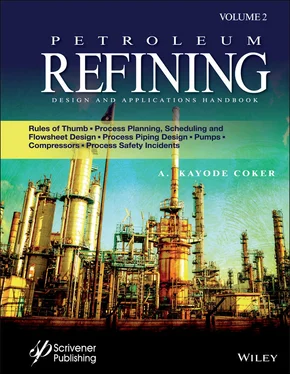A. Kayode Coker - Petroleum Refining Design and Applications Handbook
Здесь есть возможность читать онлайн «A. Kayode Coker - Petroleum Refining Design and Applications Handbook» — ознакомительный отрывок электронной книги совершенно бесплатно, а после прочтения отрывка купить полную версию. В некоторых случаях можно слушать аудио, скачать через торрент в формате fb2 и присутствует краткое содержание. Жанр: unrecognised, на английском языке. Описание произведения, (предисловие) а так же отзывы посетителей доступны на портале библиотеки ЛибКат.
- Название:Petroleum Refining Design and Applications Handbook
- Автор:
- Жанр:
- Год:неизвестен
- ISBN:нет данных
- Рейтинг книги:3 / 5. Голосов: 1
-
Избранное:Добавить в избранное
- Отзывы:
-
Ваша оценка:
- 60
- 1
- 2
- 3
- 4
- 5
Petroleum Refining Design and Applications Handbook: краткое содержание, описание и аннотация
Предлагаем к чтению аннотацию, описание, краткое содержание или предисловие (зависит от того, что написал сам автор книги «Petroleum Refining Design and Applications Handbook»). Если вы не нашли необходимую информацию о книге — напишите в комментариях, мы постараемся отыскать её.
Petroleum Refining Design and Applications Handbook — читать онлайн ознакомительный отрывок
Ниже представлен текст книги, разбитый по страницам. Система сохранения места последней прочитанной страницы, позволяет с удобством читать онлайн бесплатно книгу «Petroleum Refining Design and Applications Handbook», без необходимости каждый раз заново искать на чём Вы остановились. Поставьте закладку, и сможете в любой момент перейти на страницу, на которой закончили чтение.
Интервал:
Закладка:
4 Chapter 17Table 17.1 General compression and vacuum limits.Table 17.2 Comparison of performance for propane.Table 17.3 Compressibility factors, Z.Table 17.4 Approximate ratio of specific heats (“k” values) for various gases.Table 17.5 Constants for molal heat capacity.Table 17.5A Molal heat capacity MCp (ideal-gas state), kJ/mole °C.Table 17.6 Typical reciprocating air compressor data.Table 17.7 Index or rating leakages for single-sealing elements.Table 17.8A General material specifications for noncorrosive applications.Table 17.8B Cast casing materials for low-temperature applications.Table 17.8C Welded casing material for low-temperature applications.Table 17.8D Impeller material for low-temperature applications.Table 17.8E Materials for usual construction of components for process type gas ...Table 17.8F Typical materials of construction for selected centrifugal applicati...Table 17.9A Summary of typical multistage compressor data.Table 17.9B Summary of typical multistage centrifugal compressor data.Table 17.9C Centrifugal Compressor flow range.Table 17.10 Properties of the gas mixture.Table 17.11 Input data and computer results of Example 17.10.Table 17.12 Polytropic efficiencies for various types of machines.Table 17.13 Approximate mechanical losses as a percentage of a gas power require...Table 17.14 The feed components and the mole fractions.Table 17.15 Properties of the gas mixture.Table 17.16 Input data and computer results of Example 17.14.Table 17.17 Application in the natural gas compression, petroleum, and petrochem...Table 17.17A General sizes of various compressors used in the industrial gas ind...Table 17.18 Typical diaphragm compressor process construction materials.Table 17.19 Troubleshooting checklist for reciprocating compressors.Table 17.20 Troubleshooting checklist for centrifugal compressors.
5 Glossary of Petroleum and Technical TerminologyTable 1 Octane numbers of pure hydrocarbons *Table 2 RVP blending values.
List of Illustrations
1 Chapter 14 Figure 14.1 A process engineering section supervision chart (Ludwig [1]). Figure 14.2 Typical organization of “engineering planning team” [2]. Figure 14.3 The total plant design project. Figure 14.4 Partitioning the process design task into interrelated subtasks (sou... Figure 14.5 Block flow diagram of hydrocracker overview. Figure 14.6a Heat and material balance-established material and thermal requirem... Figure 14.6b Process flow diagram of (feed and fuel desulfurization sections) [9... Figure 14.6c Process flow diagram of atmospheric fractionator. Figure 14.7 Mechanical detail flow diagram [9]. Figure 14.8 Piping and Instrumentation (P & ID) diagram for ammonia plant [9]. Figure 14.9 Piping details isometric diagram [9]. Figure 14.10 Isometric diagram of a process line [9]. Figure 14.11 Standard type laying for service piping diagram. Figure 14.12 Process Engineering flow scheme (Crude distiller unit 1000 air cool... Figure 14.13 Typical process area plot plan and study elevations [9]. Figure 14.14 Flowsheet scale reference diagram [11]. Figure 14.15 (a) Computer-generated P & ID flowsheet [9] (b) Computer-generated ... Figure 14.16 (a) Process variables; (b) Pumps and solids [9]. (c) Storage and eq... Figure 14.17 (a) Special types of descriptive flowsheet symbols [9]. (b) Commonl... Figure 14.18 Examples of line numbering. Figure 14.19 Use of alphabetic suffixes with line symbols. Figure 14.20a Line schedule. Figure 14.20b Pipe line list. Figure 14.20c Line schedule sheet. Figure 14.20d Line summary table. Figure 14.21 Typical valve codes and specifications. By permission, Borden Chemi... Figure 14.22 Partial presentation of piping materials specifications for a speci... Figure 14.23 Centrifugal pump summary. Figure 14.24a Centrifugal pump schedule. Figure 14.24b Centrifugal pump schedule. Figure 14.25 Vessel and tank summary sheet. Figure 14.26 Vessel and tank schedule. Figure 14.27 General services and utilities checklist. Figure 14.28 Process engineering job analysis summary.
2 Chapter 15 Figure 15.1 Refinery and chemical plant layouts (source: (a, b) Coker, A. K. [Lu... Figure 15.2 Distribution of fluid energy in a pipeline. Figure 15.3 Pressure level references. Adapted by permission from Crane Co., Tec... Figure 15.4 Portion of a plant piping system (by permission from Spiral Sarco, I... Figure 15.5 Moody or “regular” Fanning friction factors for any kind and size of... Figure 15.6a Forged steel threaded pipe fittings (water, oil, or gas service). N... Figure 15.6b Forged steel socket weld fittings. WOG (water, oil, or gas service)... Figure 15.6c Forged steel welded—end fittings (source: Tube Turn Technologies, I... Figure 15.6d Dimension comparison of tubing and IPS (iron pipe size) steel pipin... Figure 15.7 Branch connections for welding openings into steel pipe. See Figure ... Figure 15.7a A block diagram for calculating ΔP for a given flow rate/velocity. Figure 15.7b Optimum economic pipe diameter. Figure 15.8a Relative roughness of pipe materials and friction factors for compl... Figure 15.8b Relative roughness of pipe materials and friction factors for compl... Figure 15.9a Resistance coefficients for valves and fittings (source: Hydraulic ... Figure 15.9b Resistance coefficients for valves and fittings (source: Hydraulic ... Figure 15.10 Variation of specific gravity with temperature for various petroleu... Figure 15.11 Viscosity and Newton’s law. Figure 15.12 Vapor pressure chart for various petroleum products (source: E. Sha... Figure 15.13 The Excel spreadsheet snapshot of Example 15.2.Figure 15.14 Configuration of 60°F crude oil conduit system.Figure 15.15a Various tap locations for orifice meter.Figure 15.15b Pipe diameter from the inlet face of the orifice plate. Extracted ...Figure 15.15c Orifice meter with vena contracta formation.Figure 15.15d Flow nozzle with differential gauge.Figure 15.15e Venturi meter.Figure 15.15f Coriolis mass flow meter (source: Micro Motion, Inc. USA).Figure 15.16 Flow coefficients “C” for nozzles. C based on the internal diameter...Figure 15.17 Flow coefficients “C” for squared-edged orifices (source: Crane [4]...Figure 15.18 Orifice discharge coefficient for square-edged orifice and flange, ...Figure 15.19 Piping layout for Example 15.8.Figure 15.20a Piping and instrumentation diagram of the debutanizer unit 1000.Figure 15.20b Piping and instrumentation diagram of the debutanizer pump accumul...Figure 15.21 Pipe flow chart nomogram (source: Sandler, H. J and E. T. Luckiewic...Figure 15.22 Establishing control valve estimated pressure drop.Figure 15.23 Fluid flow through heat exchanger, relief valve, and tail pipe.Figure 15.24 The Excel spreadsheet snapshot of Example 15.13Figure 15.25a Net expansion factor, Y, for compressible flow through pipe to a l...Figure 15.25b Net expansion factor, Y, for compressible flow through pipe to a l...Figure 15.25c Critical pressure ratio, rc, for compressible flow through nozzles...Figure 15.26a Pressure drop in compressible flow lines (reprinted/adapted with p...Figure 15.26b Pressure drop in compressible flow lines (metric units) (reprinted...Figure 15.27a Simplified flow formula for compressible fluids (reprinted/adapted...Figure 15.27b Simplified flow formula for compressible fluids (metric units) (re...Figure 15.28 Steam flow chart (by permission from Walworth Co. Note: Used for es...Figure 15.29a Velocity in compressible flow lines (reprinted/adapted with permis...Figure 15.29b Velocity in compressible flow lines (metric units) (reprinted/adap...Figure 15.30 Discharge coefficients for liquid flow (by permission, Cameron Hydr...Figure 15.31a Flow patterns for horizontal two-phase flow (based on data from 1,...Figure 15.31b Baker parameters for horizontal two-phase flow regimes with modifi...Figure 15.32 Representatives forms of horizontal two-phase flow patterns, same a...Figure 15.33 Lockhart–Martinelli pressure drop correlation (source: Lockhart–Mar...Figure 15.34 Estimating pressure drop in uphill sections of pipeline for two-pha...Figure 15.35 Configurations of piping for sample problem of Example 15.24 [56].Figure 15.36 Excel spreadsheet calculation of Example 15.25.Figure 15.37 Flow patterns in vertical liquid–gas flow (source: S. M. Walas, Che...Figure 15.38 Slug/forth transition in concurrent vertical upflow of air–water mi...Figure 15.39 Evaluation curves for friction losses of air steam flowing turbulen...Figure 15.40 Friction factor for streamlined flow of air at absolute pressures f...Figure 15.41 Absolute viscosity of air (source: Standard for Steam Jet Ejectors,...Figure 15.42 Typical flow velocities for vacuum lines. Note: 1 torr = 1.33 mb = ...Figure 15.43 Acceptable pressure losses between the vacuum vessel and the vacuum...Figure 15.44 Typical steam condensate flashing operation.Figure 15.45 Sarco flashing steam condensate line sizing flow chart (source: Spi...Figure 15.46 Flashing steam condensate line sizing chart (source: Ruskin, R. P.,...Figure 15.47 Line size sheet. Example of pressure drop for a vapor system, Examp...Figure 15.48 Pressure drop, Dowtherm “A” ® vapor in steel pipe (by permission fr...Figure 15.49 Process flow diagram of the Case study using PIPESYS software (cour...Figure 15.50a Flowing pressure profile of Pipe-100.Figure 15.50b Flowing temperature profile of Pipe-100.Figure 15.50c Flowing pressure profile of Pipe-101.Figure 15.50d Flowing temperature profile of Pipe-101.
Читать дальшеИнтервал:
Закладка:
Похожие книги на «Petroleum Refining Design and Applications Handbook»
Представляем Вашему вниманию похожие книги на «Petroleum Refining Design and Applications Handbook» списком для выбора. Мы отобрали схожую по названию и смыслу литературу в надежде предоставить читателям больше вариантов отыскать новые, интересные, ещё непрочитанные произведения.
Обсуждение, отзывы о книге «Petroleum Refining Design and Applications Handbook» и просто собственные мнения читателей. Оставьте ваши комментарии, напишите, что Вы думаете о произведении, его смысле или главных героях. Укажите что конкретно понравилось, а что нет, и почему Вы так считаете.












